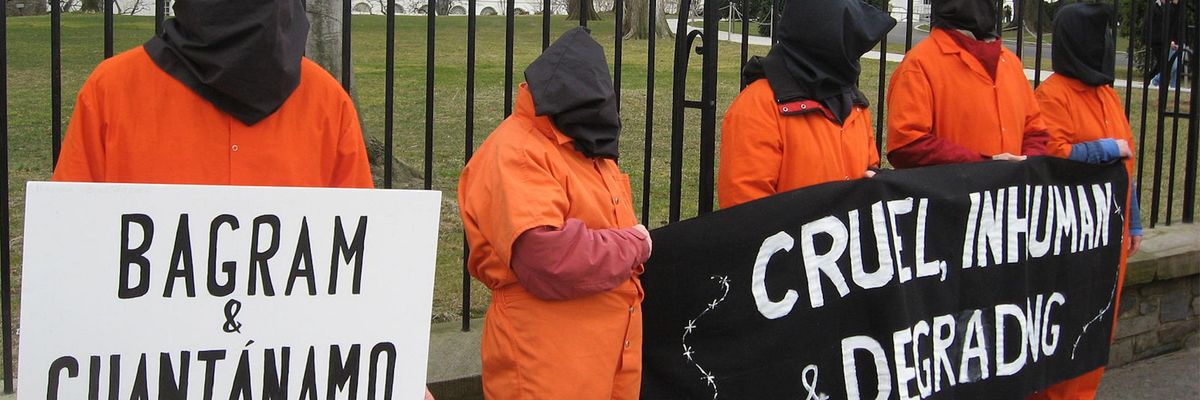
Activists protest U.S. torture at Bagram Air Base in Afghanistan and at Guantanamo Bay in front of the White House in Washington, D.C. on February 27, 2009. (Photo: mike.benedetti/Flickr/cc)
Ex-Prisoners Recall US Torture at 'Afghanistan's Abu Ghraib'
"It is psychologically hard for me to recall all that was happening," said one former Bagram Air Base inmate. "The torture was mostly done by Afghans, sometimes the Americans. But the orders came from the U.S."
In a chilling reminder of the war crimes committed during the 20-year Afghanistan War, former inmates of a notorious prison at the largest U.S. military base in the country recently returned there to recount the torture and other horrors they endured during their captivity.
"They used to tie us to this chair, our hands and feet, and then applied electric shocks."
--Hajimumin Hamza, former prisoner
Al Jazeera reported Tuesday that former prisoner Hajimumin Hamza recently led the Taliban fighters who now control Bagram Air Base in Parwan province on a tour of the facility that once held more than 5,000 people, including children, and has been called "Afghanistan's Abu Ghraib."
"There were a lot of different forms of torture, including sexual abuse," Hamza told Al Jazeera. "It is psychologically hard for me to recall all that was happening. The torture was mostly done by Afghans, sometimes the Americans. But the orders came from the U.S."
"They used to tie us to this chair, our hands and feet, and then applied electric shocks," recalled Hamza, pointing to a chair. "Sometimes they used it for beatings, too."
According to Al Jazeera:
Hamza remembers much more than the electric shocks. Hanging upside down for hours. Water and tear gas being poured on sleeping prisoners from the bars on a cell's ceiling. Confinement in tiny, windowless, solitary cells for weeks or months with either no light or a bright bulb switched on 24/7.
Hamza showed where prisoners wrote on walls in Pashto and Dari.
"People were writing memories, like a diary," he explained. "We did that because we wanted to leave a testimony in case the Americans kill us. So that people know that we were here."
In May 2005, The New York Times obtained a 2,000-page U.S. Army report detailing the torture and murder of two unarmed Afghan civilians named Habibullah and Dilawar at Bagram, part of a wider pattern of at least dozens of detainee and prisoner homicides committed by U.S. forces in Afghanistan and Iraq during the so-called War on Terror.
Fifteen low-ranking U.S. soldiers--including one who served at the notorious Abu Ghraib torture prison in Iraq--were court-martialed and charged with crimes ranging from assault to involuntary manslaughter in connection with the deaths of Habibullah and Dilawar. Some of the soldiers were acquitted; others received reprimands and rank reductions. Two of the troops were sentenced to prison terms of two and five months.
In 2012, Human Rights Watch and others revealed that more than 200 teenagers and children--some reportedly as young as 11 years old--were imprisoned at a U.S. military prison next to Bagram.
Moazzam Begg--a British citizen who was imprisoned for three years, first at Bagram and then at Guantanamo Bay, before being released without charge or trial--and others have also asserted that Aafia Siddiqui, a U.S.-educated Pakistani neuroscientist, was held for years as the only woman prisoner at Bagram.
\u201cI heard the screams of a woman in #Bagram while the #FBI and #CIA tortured me. That torture centre has been liberated but #Aafia remains in prison on bogus, unrealistic charges. The #WarOnTerror has failed after defeat in #Afghanistan. It\u2019s time to #Free_Sister_Aafia\u201d— Moazzam Begg (@Moazzam Begg) 1631914294
Begg, who is now the outreach director at the U.K.-based advocacy group CAGE, recently called Siddiqui's imprisonment--she is currently serving an 86-year sentence in a federal penitentiary in Texas for allegedly trying to kill U.S. troops during an interrogation--"one of the most troubling in the sordid history of the War on Terror."
An Urgent Message From Our Co-Founder
Dear Common Dreams reader, The U.S. is on a fast track to authoritarianism like nothing I've ever seen. Meanwhile, corporate news outlets are utterly capitulating to Trump, twisting their coverage to avoid drawing his ire while lining up to stuff cash in his pockets. That's why I believe that Common Dreams is doing the best and most consequential reporting that we've ever done. Our small but mighty team is a progressive reporting powerhouse, covering the news every day that the corporate media never will. Our mission has always been simple: To inform. To inspire. And to ignite change for the common good. Now here's the key piece that I want all our readers to understand: None of this would be possible without your financial support. That's not just some fundraising cliche. It's the absolute and literal truth. We don't accept corporate advertising and never will. We don't have a paywall because we don't think people should be blocked from critical news based on their ability to pay. Everything we do is funded by the donations of readers like you. Will you donate now to help power the nonprofit, independent reporting of Common Dreams? Thank you for being a vital member of our community. Together, we can keep independent journalism alive when it’s needed most. - Craig Brown, Co-founder |
In a chilling reminder of the war crimes committed during the 20-year Afghanistan War, former inmates of a notorious prison at the largest U.S. military base in the country recently returned there to recount the torture and other horrors they endured during their captivity.
"They used to tie us to this chair, our hands and feet, and then applied electric shocks."
--Hajimumin Hamza, former prisoner
Al Jazeera reported Tuesday that former prisoner Hajimumin Hamza recently led the Taliban fighters who now control Bagram Air Base in Parwan province on a tour of the facility that once held more than 5,000 people, including children, and has been called "Afghanistan's Abu Ghraib."
"There were a lot of different forms of torture, including sexual abuse," Hamza told Al Jazeera. "It is psychologically hard for me to recall all that was happening. The torture was mostly done by Afghans, sometimes the Americans. But the orders came from the U.S."
"They used to tie us to this chair, our hands and feet, and then applied electric shocks," recalled Hamza, pointing to a chair. "Sometimes they used it for beatings, too."
According to Al Jazeera:
Hamza remembers much more than the electric shocks. Hanging upside down for hours. Water and tear gas being poured on sleeping prisoners from the bars on a cell's ceiling. Confinement in tiny, windowless, solitary cells for weeks or months with either no light or a bright bulb switched on 24/7.
Hamza showed where prisoners wrote on walls in Pashto and Dari.
"People were writing memories, like a diary," he explained. "We did that because we wanted to leave a testimony in case the Americans kill us. So that people know that we were here."
In May 2005, The New York Times obtained a 2,000-page U.S. Army report detailing the torture and murder of two unarmed Afghan civilians named Habibullah and Dilawar at Bagram, part of a wider pattern of at least dozens of detainee and prisoner homicides committed by U.S. forces in Afghanistan and Iraq during the so-called War on Terror.
Fifteen low-ranking U.S. soldiers--including one who served at the notorious Abu Ghraib torture prison in Iraq--were court-martialed and charged with crimes ranging from assault to involuntary manslaughter in connection with the deaths of Habibullah and Dilawar. Some of the soldiers were acquitted; others received reprimands and rank reductions. Two of the troops were sentenced to prison terms of two and five months.
In 2012, Human Rights Watch and others revealed that more than 200 teenagers and children--some reportedly as young as 11 years old--were imprisoned at a U.S. military prison next to Bagram.
Moazzam Begg--a British citizen who was imprisoned for three years, first at Bagram and then at Guantanamo Bay, before being released without charge or trial--and others have also asserted that Aafia Siddiqui, a U.S.-educated Pakistani neuroscientist, was held for years as the only woman prisoner at Bagram.
\u201cI heard the screams of a woman in #Bagram while the #FBI and #CIA tortured me. That torture centre has been liberated but #Aafia remains in prison on bogus, unrealistic charges. The #WarOnTerror has failed after defeat in #Afghanistan. It\u2019s time to #Free_Sister_Aafia\u201d— Moazzam Begg (@Moazzam Begg) 1631914294
Begg, who is now the outreach director at the U.K.-based advocacy group CAGE, recently called Siddiqui's imprisonment--she is currently serving an 86-year sentence in a federal penitentiary in Texas for allegedly trying to kill U.S. troops during an interrogation--"one of the most troubling in the sordid history of the War on Terror."
In a chilling reminder of the war crimes committed during the 20-year Afghanistan War, former inmates of a notorious prison at the largest U.S. military base in the country recently returned there to recount the torture and other horrors they endured during their captivity.
"They used to tie us to this chair, our hands and feet, and then applied electric shocks."
--Hajimumin Hamza, former prisoner
Al Jazeera reported Tuesday that former prisoner Hajimumin Hamza recently led the Taliban fighters who now control Bagram Air Base in Parwan province on a tour of the facility that once held more than 5,000 people, including children, and has been called "Afghanistan's Abu Ghraib."
"There were a lot of different forms of torture, including sexual abuse," Hamza told Al Jazeera. "It is psychologically hard for me to recall all that was happening. The torture was mostly done by Afghans, sometimes the Americans. But the orders came from the U.S."
"They used to tie us to this chair, our hands and feet, and then applied electric shocks," recalled Hamza, pointing to a chair. "Sometimes they used it for beatings, too."
According to Al Jazeera:
Hamza remembers much more than the electric shocks. Hanging upside down for hours. Water and tear gas being poured on sleeping prisoners from the bars on a cell's ceiling. Confinement in tiny, windowless, solitary cells for weeks or months with either no light or a bright bulb switched on 24/7.
Hamza showed where prisoners wrote on walls in Pashto and Dari.
"People were writing memories, like a diary," he explained. "We did that because we wanted to leave a testimony in case the Americans kill us. So that people know that we were here."
In May 2005, The New York Times obtained a 2,000-page U.S. Army report detailing the torture and murder of two unarmed Afghan civilians named Habibullah and Dilawar at Bagram, part of a wider pattern of at least dozens of detainee and prisoner homicides committed by U.S. forces in Afghanistan and Iraq during the so-called War on Terror.
Fifteen low-ranking U.S. soldiers--including one who served at the notorious Abu Ghraib torture prison in Iraq--were court-martialed and charged with crimes ranging from assault to involuntary manslaughter in connection with the deaths of Habibullah and Dilawar. Some of the soldiers were acquitted; others received reprimands and rank reductions. Two of the troops were sentenced to prison terms of two and five months.
In 2012, Human Rights Watch and others revealed that more than 200 teenagers and children--some reportedly as young as 11 years old--were imprisoned at a U.S. military prison next to Bagram.
Moazzam Begg--a British citizen who was imprisoned for three years, first at Bagram and then at Guantanamo Bay, before being released without charge or trial--and others have also asserted that Aafia Siddiqui, a U.S.-educated Pakistani neuroscientist, was held for years as the only woman prisoner at Bagram.
\u201cI heard the screams of a woman in #Bagram while the #FBI and #CIA tortured me. That torture centre has been liberated but #Aafia remains in prison on bogus, unrealistic charges. The #WarOnTerror has failed after defeat in #Afghanistan. It\u2019s time to #Free_Sister_Aafia\u201d— Moazzam Begg (@Moazzam Begg) 1631914294
Begg, who is now the outreach director at the U.K.-based advocacy group CAGE, recently called Siddiqui's imprisonment--she is currently serving an 86-year sentence in a federal penitentiary in Texas for allegedly trying to kill U.S. troops during an interrogation--"one of the most troubling in the sordid history of the War on Terror."

